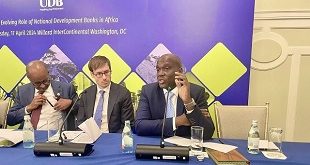
By Charles Onyango-Obbo
Inside the belly of the beast
I have just spent a few days in the countryside, and I noticed one change from just five or so years ago; everyone is talking about “how bad corruption is in Uganda”. Some refer to the various incidents of corruption involving people close to President Yoweri Museveni in very troubling tribal terms.
Perhaps no other news publication has attempted to examine the structure of and why corruption is such big time in Uganda, than The Independent. In various articles in both The Independent, and recently in Daily Monitor, The Independent’s Andrew Mwenda has argued that the very rot that corruption causes, is why corruption exists and thrives. In other words, corruption is such a strong evil force because it’s very good at giving birth to itself.
I think there is a range of other critical factors at play in the Corruption Inc. Uganda, which we need to examine if post-Museveni governments are to deal with this problem – because it is no longer possible to do it under the NRM.
To start, we need to examine further the whole issue of the reproduction of patronage that we have touched on above. Let us take a theoretical example. Assume the government was building a new road to Fort Portal.

If the road were; one, built on time and on budget and two, built to last 25 years without need of repair, what would happen? After eight years people will take good roads for granted. They become part of the furniture, and soon the government ceases to gain political capital from it.
However, if the same road that was supposed to be built for Shs 3 billion in two years, ends up being built five years late (like the road to the Jinja-Iganga-Tororo-Busia Road to the Kenya border) and costing Shs 36 billion, it means a corrupt contractor can continue to eat money for five years on a road, instead of two years. And the corrupt become vested in the continued stay in power of the government that is feeding them.
However, if a road were to last 25 years, that would be five election cycles without feeding your contractors as the president–and therefore they will not be beholden to you. Besides, if a constructor won a road construction contract on merit and delivered it at a cost effective price, government will not have done him any favours; and he will not feel beholden to the sitting president.
So the roads must not last long. Thus when the government announced recently that it would release Shs 90 billion for roads that are supposed to be finished by February, it was a big joke! We know that 25-40 percent of that money is going back as payments to fund state-favoured candidates in the campaigns for next year’s elections.
You could say that in Uganda’s case, the top state leaders have the kind of relationship a doctor has with disease. Doctors are healers and go to extra lengths to do it. However, they also do not want diseases to go away, because then they would have no business.
Therefore, if Uganda developed an efficient government, where roads are fixed and there are still no potholes in them after 10 years, it would lose the absorption capacity for patronage. And the NRM as we know it would have to transform its modus operandi or face the spectre of collapse.
One reason for this is that every political change sends out political signals; just the way a free market sends out various signals for investors. Some investors respond one way and make a fortune; others do the opposite and lose fortunes. So the key is in HOW and WHY leaders choose the signals that they do, and ignore others.
To understand this better, let us compare Rwanda and Uganda – or better still President Paul Kagame and our own Yoweri Museveni, on how they responded the signals.
When Kagame led the Rwanda Patriotic Army/Front to victory in Rwanda in 1994, he and his comrades faced a country in which an extremist Hutu and opportunistic Tutsi elite had led the masses into participating in the wholesale murder of nearly one million Tutsi and opposition Hutus.
The result is that Rwanda was a country in which the Hutu were bracing for Tutsi revenge. Now the Hutu elite, by their role in crafting the leadership, had made it impossible for the RPA to work with them. It was a stroke of evil genius, if you think of it, because it left the RPA the one obvious choice that would have ensured that they would be defeated in a short period – to go it alone, as a small isolated bunch of Tutsi victors lording it over a Hutu majority.
In other words, the only quick-win constituency for the RPA to work with was a tiny Tutsi, not the Hutu, elite. Yet the only mass constituency Kagame & Co. had was the Hutu. But they could not get to them through the Hutu elite, as we have shown. They had to reach over the heads of the Hutu tribal warlords.

| Uganda’s worsening Corruption Perception Indices since 1998 |

Now, when you have to deal with millions of people, you cannot do it on a one-to-one basis. You can only do so through institutions that offer services on a mass scale. The only way to be effective in such a situation is to standardise. And if you standardise the delivery of services, it means that a Hutu and Tutsi will get equal treatment. And, most critically, if you standardise, you must get rid of corruption, because corruption is one way of differential allocation of public resources (i.e. it is the only way you can give Andrew a free bail out of loan from the Bank of Uganda, but deny it to Charles).
In short, a corrupt Kagame would not have been effective. Because he did not have a ready-made large constituency to shower with patronage, the pay-off from corruption would have been minimal.
 The Independent Uganda: You get the Truth we Pay the Price
The Independent Uganda: You get the Truth we Pay the Price


